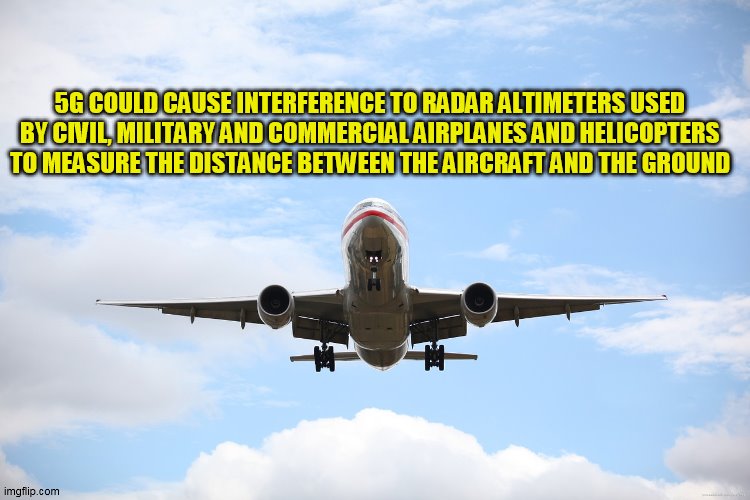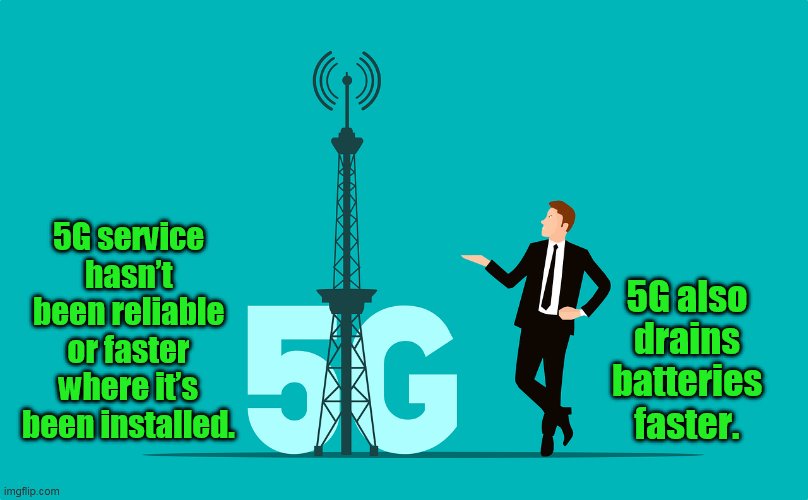 By B.N. Frank
By B.N. Frank
Fly much? 5G warnings and opposition has limited, slowed, and/or stopped deployment including near some U.S. airports due to dangerous interference issues with aviation equipment (see 1, 2, 3). Aviation representatives continue to ask that this be resolved.
From Fierce Wireless:
Aviation groups suggest codifying 5G C-band limits
Representatives of the aviation industry met with staff at the FCC earlier this week to discuss steps the industry has taken to harden radar altimeter hardware in “thousands of aircraft” to ensure better performance near C-band wireless operations.
However, they’re also asking the agency to consider more permanent changes on the part of C-band licensees – namely, AT&T and Verizon – ahead of the next round of 5G C-band deployments in July and December of next year.
The FCC auctioned off C-band spectrum between 3.7-3.98 GHz in 2021, with Verizon and AT&T spending more than $45 billion and $23 billion, respectively, before clearing costs. But later in the year, the battle with the Federal Aviation Administration (FAA) and aviation industry turned into a fiasco, with aviation groups warning about potential plane crashes due to interference from C-band signals.
The culprit: old radio altimeters in the 4.2-4.4 GHz band that lack proper filtering technology, despite a 220-megahertz guard band. The airline industry is racing to replace the old technology with modern, more precise equipment.
In June, the FAA announced that it would take another year to solve problems with altimeters on major airlines.
Related: AT&T, Verizon give FAA another year to fix airplane altimeters
Now the airlines and aviation officials appear to making a bigger ask of the wireless carriers.
In an October 3 filing with the FCC, the aviation industry said it’s “working hard to reach retrofit deadlines,” and that “codifying limits to telecom can help aviation make investments in retrofits safe and not at a risk.”
Airlines for America, Air Line Pilot Association International, American Airlines and Garmin International were among those represented in the meetings with staff from the FCC’s Office of Engineering and Technology, Office of General Counsel and the Wireless Telecommunications Bureau.
“Reasonable 5G network/equipment limits are feasible and would avoid aviation implementing costly additional mitigations that are unnecessary given 5G’s operational use cases,” the airline officials said in bullet points presented to the commission.
This is NUTS:
“The aviation industry wants the FCC to consider codifying 5G temporary interference mitigation techniques at or near airports that C-band licensees Verizon Communications, Inc., and AT&T, Inc., agreed to on a temporary basis to protect radio altimeters” 1/2
— Preston Padden (@BoulderPreston) October 7, 2022
The aviation industry listed some examples of what they think could be considered ahead of the next round of 5G deployments in July and December of 2023. Among them, under the heading “5G Antenna Uptilt Limit,” are:
- 25+ dBi gain makes a significant difference to interference calculations with aircraft if pointing up or down
- Temporary FAA/5G mitigations have applied an uptilt limit with no apparent issues
By way of background, the aviation officials said that on January 19, 2022, A Block licensees AT&T and Verizon agreed to maintain lower power levels and antenna tilt downs near major airports until July 2023. The service turn-up date in the B and C Blocks in the 46 Partial Economic Areas (PEAs) and in the A, B and C Blocks in the remaining 360 PEAs is December 5, 2023.
With those deadlines in mind, the FAA and the aviation industry (including airlines, airframe manufacturers and avionics manufacturers) have been implementing retrofits of radio altimeters to protect them from 5G interference, the filing stated.
Verizon didn’t have a lot to say about the matter when Fierce asked for comment. “We are engaging in ongoing conversations with the FAA and are making good progress towards our goals,” the company said in a statement.
Fierce also reached out to AT&T and will update this story with any comment from them.
Activist Post is Google-Free
Support for just $1 per month at Patreon or SubscribeStar
Of course, warnings about 5G interference issues are not isolated to aviation equipment. In 2020, utility companies and associations filed lawsuits against the Federal Communications Commission (FCC) for not protecting utility infrastructure from potential electrical interference issues with 5G (see 1, 2). Telecom provider, SpaceX has complained that Dish’s 5G satellites will cause interference issues affecting Starlink satellite service. DirecTV and RS Submit have also complained about satellite interference issues. The Department of Defense (DoD) has also been trying to resolve potential 5G network interference issues with military radar. In August, a bi-partisan group of senators requested that the FCC reconsider harmful interference risks with associated Ligado’s network before allowing it to be activated. Fortunately last month, Ligado cancelled trial network plans, maybe because of a new report that also warned about interference.
Of course, there have been other significant 5G issues reported including poor service (see 1, 2, 3, 4, 5, 6, 7, 8, 9), cybersecurity (see 1, 2), health, and environmental risks (see 1, 2, 3, 4). Since 2017 doctors and scientists have asked for 5G moratoriums on Earth and in space (see 1, 2) due to biological and environmental health risks and the majority of scientists oppose deployment. Since 2018 there have been reports of people and animals experiencing symptoms and illnesses after it was activated (see 1, 2. 3, 4, 5). In 2019, telecom executives gave congressional testimony that they had NO scientific evidence that 5G is safe. Some researchers have also suggested that activation may be contributing to COVID-19 infections as well as hundreds of thousands if not millions of bird deaths. Of course, there are confirmed health risks associated with exposure to 4G and other sources of wireless Wi-Fi radiation and Electromagnetic Fields (aka “Electrosmog”) too. Nevertheless, the FCC (see 1, 2, 3, 4, 5, 6, 7, 8) and other American government and state agencies and committees (see 1, 2, 3, 4, 5, 6, 7) have continued to promote and fund 5G deployment and densification (see 1, 2) as well as that of 4G and public Wi-Fi (which also poses known risks).
Regardless 5G doesn’t seem to be the end goal anyway – it’s 6G which isn’t without risks either (see 1, 2).
Activist Post reports regularly about 5G and other unsafe technologies. For more information, visit our archives and the following websites:
- Americans for Responsible Technology
- Wireless Information Network
- Environmental Health Trust
- Physicians for Safe Technology
Become a Patron!
Or support us at SubscribeStar
Donate cryptocurrency HERE
Subscribe to Activist Post for truth, peace, and freedom news. Follow us on SoMee, Telegram, HIVE, Flote, Minds, MeWe, Twitter, Gab, What Really Happened and GETTR.
Provide, Protect and Profit from what’s coming! Get a free issue of Counter Markets today.


Be the first to comment on "Aviation Officials and Airlines Ask FCC “to consider more permanent changes” to Reduce 5G Interference Risks"